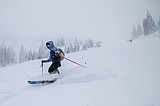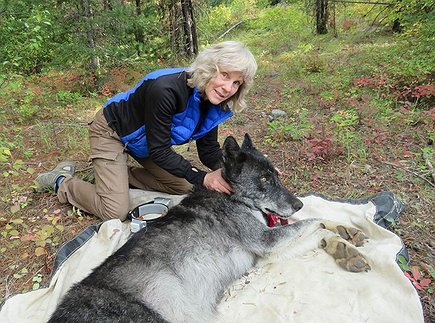Natural migration and federal protections aided Northwest Montana's wolf recovery
KATE HESTON | Hagadone News Network | UPDATED 1 year, 1 month AGO
Kate Heston covers politics and natural resources for the Daily Inter Lake. She is a graduate of the University of Iowa's journalism program, previously worked as photo editor at the Daily Iowan and was a News21 fellow in Phoenix. She can be reached at [email protected] or 406-758-4459. | November 1, 2024 12:00 AM
A female gray wolf stepped over the Canadian border and into Montana 45 years ago. Her name was Kishinena.
Kishinena weighed about 80 pounds, had a range of up to 30 miles on each side of the border north of Glacier National Park and was believed to be running with at least a few other wolves upon her crossing into the U.S.
Named after a creek in southeast British Columbia, Kishinena was the first wolf captured and collared by biologists in the North Fork of the Flathead drainage in 1979 after the species had been eradicated from the region decades prior.
Around 1981, the unlikely happened — Kishinena crossed paths with a male wolf that had also ventured into the North Fork. Together with their pups the Magic Pack was established. It would grow to a dozen wolves in just five years and become the catalyst for the eventual return of the wolf to Montana.
Today it is estimated that more than 1,000 wolves roam freely across Montana, and it all began with Kishinena — arguably the most heralded recovery success story in the Endangered Species Act’s 50-year history.
WOLVES ONCE existed throughout Montana, from the west's alpine forests to the east's rolling plains. The large canines, with thick neutral coats and an inert sense of social hierarchy, are known for their pack intelligence, predatory kinship and their history of survival amid the threat of extinction.
In the mid-1900s, gray wolves were hunted, poisoned and intentionally exterminated throughout the country. By 1936, the gray wolf was believed to be extinct in Montana; the only population to survive was confined to Minnesota.
Gray wolves were among the first species to be federally protected by the Endangered Species Preservation Act of 1966, the Endangered Species Conservation Act of 1969 and, ultimately, the Endangered Species Act of 1973, which turned 50 last December.
With time and management, however, those protections became tangible in Northwest Montana, which, today, has some of the only wolves in the Lower 48 that aren’t listed under the Endangered Species Act.
“I believe that wolves are the single most successful recovery of the Endangered Species Act that I can think of,” said Dr. Diane Boyd, a longtime and well-known wolf biologist in Northwest Montana, who just released a book about her work.
The journey to recovery, although successful, has been arduous.
Boyd has studied wolf recovery in the Rocky Mountains through multiple state and federal agencies since the 1970s. For the better part of two decades, Boyd lived to study the wolves in Northwest Montana, tracking the first natural gray wolf return: Kishinena.
“Wolves are very resilient, and if they aren't shot or poisoned, they do pretty well,” she said.
Wolf recovery in Northwest Montana differs from that of Idaho or Yellowstone National Park, where populations of gray wolves were reintroduced in the mid-1990s. Beginning with Kishinena, wolves naturally migrated into Northwest Montana.
As numbers slowly began to rise throughout the 1980s and 90s, the North Fork population acted as a bridge for the Canadian source population. At that point, set populations within Glacier National Park were able to survive.
Boyd and other experts through the Wolf Ecology Project at the University of Montana were collaring and tracking the population, publishing papers about their recovery status. She notes that the species was socially embraced at the time — the public wanted to see wolf numbers thrive.
“People tolerated them,” Boyd said. “That was a key factor.”
In 2002, Montana met the recovery goal held within the Endangered Species Act, but the wolf was not removed from the list until years later.
THE FISH AND Wildlife Service designated the gray wolf as endangered in most of the United States in 1978, except in Minnesota where the population was listed as threatened. The population in Montana is part of the Rocky Mountain population.
In 2011, Congress delisted the northern Rocky Mountains population, except for the wolves in Wyoming. This change transitioned how the state manages wolves, falling into the authority of Montana Fish, Wildlife and Parks.
In 2020 the Fish and Wildlife Service, under the Trump administration, published a rule that officially removed the gray wolf from federal protections, delisting the wolf across the country as of January 2021.
But just 15 months later, a federal judge restored their protections, placing them back on the federal list — for all but the Northern Rockies population.
While Montana’s wolves remain delisted today, the controversy surrounding that decision continues to brew.
This spring, conservation groups challenged the Fish and Wildlife Service over its failure to list the Northern Rockies population. Among their grievances, they questioned the state wildlife agency’s method of monitoring wolf populations and opposed increased methods of hunting and trapping.
Under current management, Montana has an agreement with the Fish and Wildlife Service to maintain an overall population of wolves that is high enough to prevent them from being relisted, which the state says is a minimum of 15 breeding pairs — or 150 wolves.
There are an estimated 1,087 wolves in the state today, according to Montana Fish, Wildlife and Parks. Groups challenging the figure argue that the state’s method for estimating population relies primarily on accounts from hunters and agency officials of wolf biology “rather than intensive field monitoring.”
They claim that the state’s estimated wolf count is higher than those of other models.
“Montana wouldn’t be Montana if the ESA had not protected those predators and brought them back from the brink of total eradication,” said Lizzy Pennock, carnivore coexistence attorney at WildEarth Guardians, a plaintiff in the lawsuit looking to relist the animal.
Several changes to the wolf hunting season resulted from the 2021 legislative session, including the creation of legislative intent to increase individual harvest opportunities and reduce the state wolf population.
The population would be reduced to a “lower, sustainable level,” but no lower than the minimum amount of 15 breeding pairs, according to the Montana Gray Wolf Program 2022 Annual Report.
While wolves are recovered under the Endangered Species Act in Montana, Boyd says they remain a symbol for political discussions that go beyond science.
“Wolf management is not about wolves today,” Boyd said. “It’s about people.”
Reporter Kate Heston can be reached at [email protected] or 758-4459.
Watch and Listen to The Species of Concern Series of our Deep Dive podcast on the Daily Inter Lake You Tube Channel or on your favorite podcast app.
ARTICLES BY KATE HESTON

Veteran-owned mobile boat repair service anchors down in the Flathead Valley
The Kramers launched Flathead Mobile Marine to use their skills — they have decades of experience performing routine maintenance checks on a variety of boats as well as working with engines and electrical systems — and help boaters in the community.

With ski season near, resort reaches deal with staff
After 18 months of negotiations, Whitefish Mountain Resort executives and the resort’s ski patrol union are finalizing a one-year contract for the upcoming season.

Trapped in a car wreck, Woods Bay woman credits teens with saving her life
Driving home from a quilting event in Bigfork in September of last year, Carol Martin remembered that the sky was clear, the sun was shining, and she had a headache.



